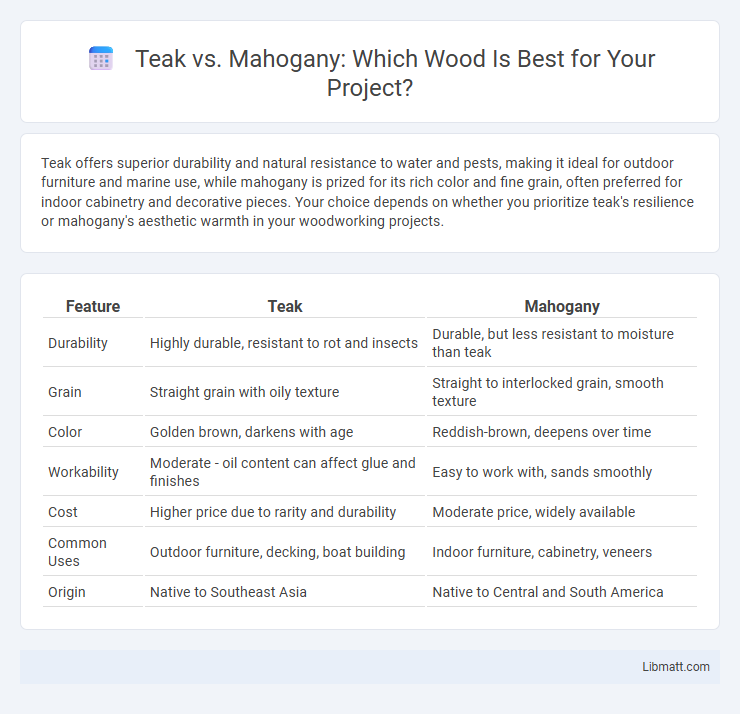Teak offers superior durability and natural resistance to water and pests, making it ideal for outdoor furniture and marine use, while mahogany is prized for its rich color and fine grain, often preferred for indoor cabinetry and decorative pieces. Your choice depends on whether you prioritize teak's resilience or mahogany's aesthetic warmth in your woodworking projects.
Table of Comparison
| Feature | Teak | Mahogany |
|---|---|---|
| Durability | Highly durable, resistant to rot and insects | Durable, but less resistant to moisture than teak |
| Grain | Straight grain with oily texture | Straight to interlocked grain, smooth texture |
| Color | Golden brown, darkens with age | Reddish-brown, deepens over time |
| Workability | Moderate - oil content can affect glue and finishes | Easy to work with, sands smoothly |
| Cost | Higher price due to rarity and durability | Moderate price, widely available |
| Common Uses | Outdoor furniture, decking, boat building | Indoor furniture, cabinetry, veneers |
| Origin | Native to Southeast Asia | Native to Central and South America |
Introduction to Teak and Mahogany
Teak and mahogany are premium hardwoods prized for their durability and rich aesthetics in furniture and construction. Teak wood, sourced primarily from South and Southeast Asia, boasts natural oils making it exceptionally resistant to water and pests. Mahogany, native to Central and South America, is celebrated for its deep reddish-brown color and fine grain, offering timeless elegance for your woodworking projects.
Origin and Growth Regions
Teak (Tectona grandis) primarily originates from Southeast Asia, with major growth regions including India, Myanmar, Thailand, and Indonesia, thriving in tropical climates with monsoon seasons. Mahogany, especially the genuine Swietenia species, is native to the Americas, particularly Central and South America, flourishing in tropical rainforests with well-drained soils. Both hardwoods require specific environmental conditions influencing their density, grain, and durability, making geographic origin crucial in determining wood quality and characteristics.
Appearance and Color Differences
Teak features a warm golden-brown hue with a straight grain and occasional wavy patterns, while mahogany displays a rich reddish-brown color that deepens over time and has a fine, even texture. The natural oils in teak contribute to its slightly oily feel and enhance its lustrous finish, contrasting with mahogany's smooth, satiny surface. Your choice between these woods will affect the aesthetic tone and ambiance of your furniture or flooring.
Durability and Hardness Comparison
Teak wood boasts exceptional durability and hardness, ranking around 1,070 on the Janka hardness scale, making it highly resistant to rot, insects, and wear, ideal for outdoor furniture and marine applications. Mahogany, with a Janka hardness rating of approximately 800-900, offers moderate durability and hardness but is less resistant to moisture and decay compared to teak. Both woods provide strength and longevity, though teak's superior natural oils and dense grain structure contribute to enhanced resilience and longevity in harsh environmental conditions.
Resistance to Weather and Pests
Teak wood is renowned for its exceptional resistance to weather and pests due to its high natural oil content, making it ideal for outdoor furniture and marine applications. Mahogany, while durable and resistant to decay, is less resistant to insect attacks and moisture compared to teak, requiring regular maintenance to prevent damage. The dense grain structure and natural oils in teak provide superior protection against rot, termites, and fungal growth, outperforming mahogany in harsh environmental conditions.
Workability and Ease of Use
Teak offers excellent workability due to its natural oils that reduce friction on tools, making it easier to cut, shape, and finish, especially for outdoor furniture. Mahogany is prized for its fine grain and smooth texture, allowing for precise carving and seamless sanding, ideal for intricate woodworking and detailed joinery. Both woods respond well to hand and machine tools, but teak's density demands sharper blades, while mahogany's consistent grain reduces the risk of splintering.
Common Uses in Furniture and Construction
Teak is widely favored for outdoor furniture and decking due to its exceptional resistance to water, rot, and insects, making it ideal for garden benches, patio sets, and boat building. Mahogany is prized in indoor furniture craftsmanship, especially for fine cabinetry, veneers, and high-end decorative pieces, valued for its rich color and smooth grain. Both woods are commonly used in luxury flooring and paneling, with teak offering superior durability and mahogany providing elegant aesthetics.
Maintenance and Longevity
Teak wood requires minimal maintenance due to its natural oils that resist moisture, pests, and decay, ensuring longevity even in outdoor settings. Mahogany, while durable and strong, needs regular sealing or varnishing to protect it from environmental damage and prolong its lifespan. Both woods offer excellent longevity, but teak's low-maintenance properties make it more suitable for long-term outdoor use.
Environmental Impact and Sustainability
Teak harvesting from responsibly managed plantations supports sustainable forestry due to its fast growth and regeneration, whereas overharvesting of mahogany, especially from the Amazon rainforest, has led to significant deforestation and habitat loss. Teak's natural durability reduces the need for chemical treatments, minimizing environmental contamination, while mahogany often requires treatments that can impact ecosystems. Certification programs like FSC (Forest Stewardship Council) are crucial for both woods to ensure sustainable sourcing and reduce illegal logging pressures on global forests.
Price and Availability Considerations
Teak is generally more expensive than mahogany due to its superior durability, resistance to moisture, and slower growth rate, making it less readily available. Mahogany tends to be more affordable and widely accessible, often sourced from sustainable plantations. Your choice may depend on budget constraints and the long-term value you seek from the wood's availability and cost.
Teak vs Mahogany Infographic

 libmatt.com
libmatt.com